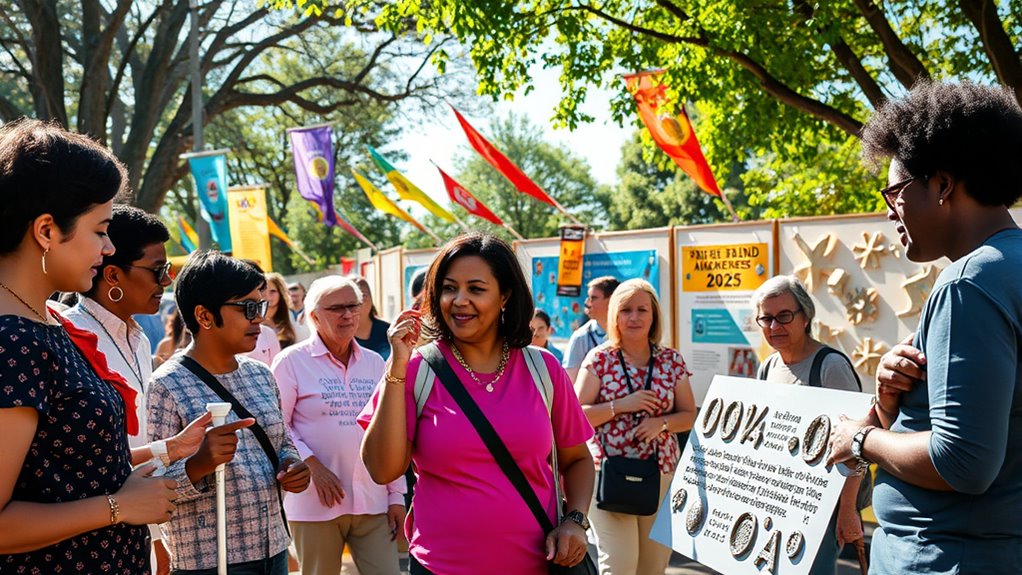In 2025, advocates are uniting to promote greater inclusion and support for the DeafBlind community. They focus on raising awareness of dual sensory impairments, pushing for better policies, and advancing innovative technologies like tactile devices and smart canes. Community programs and campaigns foster understanding and tackle social exclusion. By supporting these efforts, you can help amplify voices and create a more accessible world. If you keep exploring, you’ll uncover more ways to make a difference.
Key Takeaways
- Advocates are promoting increased awareness and community initiatives to improve inclusion for DeafBlind individuals by 2025.
- Technological innovations like tactile devices and smart canes enhance communication and independence.
- Policy efforts focus on accessible education, communication tools, and protective measures for the DeafBlind community.
- Building awareness through storytelling, campaigns, and sign language promotion fosters understanding and societal acceptance.
- Community support and advocacy are strengthening, aiming for greater inclusion, accessibility, and empowerment for DeafBlind individuals.
The Growing Movement for DeafBlind Inclusion

As awareness of DeafBlind issues grows, more organizations and individuals are actively advocating for greater inclusion. You’ll notice a strong focus on improving sensory integration, helping DeafBlind individuals navigate their environments more effectively. These efforts aim to bridge communication barriers, making interactions smoother and more accessible. Innovative technologies, like tactile devices and specialized communication methods, are gaining traction, empowering the community to connect with others and participate fully. Community programs and awareness campaigns are also playing a crucial role, fostering understanding and support. Your involvement can make a difference by supporting these initiatives or spreading awareness. Incorporating sensory integration strategies enhances their ability to interpret and respond to their surroundings, fostering greater independence and quality of life. Engaging in community outreach activities can help break down misconceptions and promote greater acceptance. Additionally, emphasizing the importance of health benefits can contribute to overall well-being and resilience within the DeafBlind community. Recognizing the significance of assistive technologies further supports their ability to communicate and engage effectively.
Key Challenges Faced by the DeafBlind Community

Despite ongoing efforts to promote inclusion, the DeafBlind community still faces significant challenges that hinder full participation in society. Sensory barriers and communication hurdles are primary obstacles. You may struggle with:
Despite efforts, the DeafBlind community still faces barriers to full inclusion and participation.
- Limited access to information due to dual sensory impairments, making it hard to stay informed. Data analysis supports better decision-making in developing accessible resources.
- Difficulties in establishing effective communication, leading to feelings of isolation.
- Restricted mobility and independence resulting from inadequate support systems.
- Social exclusion, as many environments aren’t equipped to accommodate your needs.
- Advances in assistive technologies are beginning to offer new solutions, but widespread adoption remains limited.
These challenges create a cycle of misunderstanding and marginalization. Overcoming them requires targeted efforts to bridge sensory gaps and develop accessible communication methods. Until these barriers are addressed, true inclusion remains out of reach for many in the DeafBlind community.
Innovative Technologies and Solutions in Development

Innovative technologies are transforming the way the DeafBlind community accesses information and communicates. You can now benefit from advanced assistive devices that combine tactile, visual, and auditory inputs, enhancing sensory integration. You might also explore high-quality equipment that ensures more accurate and reliable information transfer, which is crucial for effective communication. For example, wearable gadgets translate visual data into vibrations or touch, allowing you to perceive your environment more clearly. Smart canes equipped with sensors detect obstacles and relay information through haptic feedback, improving safety. Additionally, new communication tools utilize tactile displays and real-time translation, making conversations more accessible. These innovations aim to break down barriers by providing more seamless, intuitive ways to connect and gather information. Incorporating assistive technologies like these can significantly improve daily independence and participation. As technology continues to evolve, you’ll experience greater independence, enabling you to participate more fully in daily life and community activities.
Policy Initiatives and Advocacy Efforts

Advancing technology alone isn’t enough to guarantee full inclusion for the DeafBlind community; strong policy initiatives and advocacy efforts are essential to creating lasting change. You can support this by:
- Promoting Assistive Education programs that ensure equitable access to learning.
- Lobbying for Policy Reform that mandates accessible communication tools.
- Advocating for laws that fund specialized training for educators and service providers.
- Building alliances to amplify DeafBlind voices in decision-making processes. Additionally, understanding the importance of ethical hacking can support community outreach and fundraising initiatives that promote awareness and resources. This approach ensures that security measures are in place to protect sensitive information and advocate for safe online environments for vulnerable populations, including specialized communication methods that facilitate better interaction for the DeafBlind. Incorporating mindfulness techniques can also enhance community engagement and resilience in advocacy efforts. Recognizing the educational needs of the DeafBlind community is crucial for developing effective support systems and resources.
Building Awareness and Fostering Community Support

Building awareness about the DeafBlind community is essential for fostering genuine understanding and support. You can help by promoting the use of sign language as a crucial communication tool, making interactions more accessible and meaningful. Sharing stories and experiences encourages emotional awareness, helping others recognize the challenges and strengths within the DeafBlind community. Organize community events, workshops, or awareness campaigns that highlight the importance of inclusion. Educating others about DeafBlind needs and abilities dispels misconceptions and builds empathy. Your involvement can create a more welcoming environment where people feel comfortable learning and engaging. By actively spreading awareness and emphasizing emotional connections, you strengthen community support and move closer to a society that truly values diversity and inclusion for all.
Frequently Asked Questions
How Can Individuals Personally Support Deafblind Inclusion Efforts?
You can support deafblind inclusion efforts by actively engaging in sensory activities that promote understanding, like attending workshops or awareness events. Volunteer in your community to help create accessible environments, whether through technology or direct assistance. By fostering sensory engagement and participating in community volunteering, you help break down barriers, raise awareness, and guarantee that deafblind individuals receive the support and inclusion they deserve. Your involvement makes a meaningful difference.
What Are the Long-Term Goals of Deafblind Awareness 2025?
You aim to foster understanding, guarantee accessibility, and promote equal opportunities for deafblind individuals. Your long-term goals focus on advancing technological innovations, enacting meaningful policy reforms, and cultivating a more inclusive society. Through these efforts, you seek to remove barriers, enhance independence, and empower deafblind people to participate fully in all aspects of life. By championing progress, you help build a future where everyone’s abilities are recognized and supported.
Are There Specific Regions or Communities Benefiting Most From These Initiatives?
You’ll find that both rural outreach and urban programs benefit markedly from these initiatives. Rural communities often gain access to specialized resources and support services they previously lacked, while urban areas see enhanced accessibility and inclusion efforts. These programs aim to bridge gaps across regions, ensuring that people in diverse communities receive the support they need. By focusing on both rural and urban areas, the initiatives promote equitable inclusion for all deafblind individuals.
How Is Success Measured in Deafblind Advocacy Programs?
Measuring impact and fostering community engagement define success in deafblind advocacy programs. You can see progress through increased access, improved communication tools, and happier, more included individuals. When communities actively participate, advocate, and support initiatives, it signals meaningful movement. Success isn’t just statistics; it’s tangible transformation—trust, participation, and empowerment—that truly measures how well these programs serve and uplift deafblind communities.
What Role Do Businesses and Employers Play in Promoting Inclusion?
You play a crucial role in promoting inclusion by providing workplace accommodations that support deafblind individuals. By implementing effective diversity training, you can foster understanding and empathy among your team. Your efforts guarantee that deafblind employees feel valued and supported, which benefits everyone. Actively promoting accessibility measures and inclusive practices not only complies with legal standards but also creates a more diverse, innovative, and compassionate workplace environment.
Conclusion
So, as you marvel at these groundbreaking efforts, remember that true inclusion isn’t just about shiny gadgets or fancy policies. It’s about recognizing that deafblind individuals deserve more than just awareness campaigns—they need real support, understanding, and a seat at the table. So, keep pushing, stay informed, and maybe, just maybe, one day you’ll witness a world where silence and darkness no longer define anyone’s limits. Until then, keep the advocacy alive—because apparently, change is *almost* within reach.











